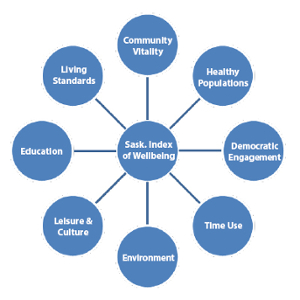
Beyond the Economy: Prioritizing Saskatchewan’s Wellbeing
This issue of JSGS Policy Brief is part of a series dedicated to exploring and providing evidence-based analysis, policy ideas, recommendations and research conclusions on the various dimensions of the pandemic, as it relates here in Canada and internationally.
By Ingrid Cazakoff, CEO, Heritage Saskatchewan; Iryna Khovrenkov, Associate Professor, Johnson Shoyama Graduate School of Public Policy; Tracey Mann, Executive Director, Community Initiatives Fund“It always seems impossible until it is done.” - Nelson Mandela
What Really Matters
Canada is one of the top ten economic leaders in the world according to Gross Domestic Product (GDP) rankings published annually by the World Bank. Canada’s economic prosperity is fuelled by its abundant natural resources, sizeable manufacturing sector and a growing seafood industry.1 Economists have coined GDP as a powerful barometer of economic success and the Canadian government, just like many others, has adopted GDP as its key economic metric in its budgets and fiscal reports. But is it the true measure? As Robert Kennedy identified in his remarks at the University of Kansas on March 18,1968:
“[GDP] does not allow for the health of our children, the quality of their education or the joy of their play. It does not include the beauty of our poetry or the strength of our marriages, the intelligence of our public debate or the integrity of our public officials. It measures neither our wit nor our courage, neither our wisdom nor our learning, neither our compassion nor our devotion to our country, it measures everything in short, except that which makes life worthwhile.”
If GDP growth is a sign of success, why is it that in Canada the leading cause of death for children aged 10 to 14 is suicide?2 Why is it that almost 40 wildfires are currently burning in Western Canada?3 Why is it that Canada still experiences a housing affordability crisis?4 These challenges call for a shift in focus, from economic measures, to what matters most—the wellbeing of people.
Canada has a set of wellbeing indicators developed as part of the Canadian Index of Wellbeing (CIW) report, which was launched in 2009. At the provincial level, Ontario (2015), Saskatchewan (2019) and Nova Scotia (2020) have all commissioned CIW to produce regional wellbeing reports. However, both nationally and provincially, we are still behind on incorporating wellbeing measurements into government decision-making around budgets and fiscal reports compared to countries such as New Zealand, which has a wellbeing budget, or Scotland, which uses wellbeing measures in its budget.
This policy brief is a call to action for Canadian governments to look beyond GDP, and to prioritize and budget for the wellbeing of their people. The COVID-19 pandemic has amplified the need to shift how governments view budgeting. From a purely economic lens, the pandemic has led to increased debt and low revenues in Saskatchewan. By shifting the focus to wellbeing and by allowing for a holistic and collaborative approaches to long-term planning and sustainability, our governments can create healthy, safe, and vibrant provinces.
What is the Saskatchewan Index of Wellbeing?
The concept of wellbeing has been researched, discussed, and debated over the past several decades, and particularly within the past ten years. To date, a universally accepted definition of wellbeing has not been found, reflecting the challenge of defining a concept that is based upon individual perspectives, as well as varying community and societal circumstances.
Heritage Saskatchewan and the Community Initiatives Fund, partners on the How are Residents of Saskatchewan Really Doing? report, which was released in October of 2019, have adopted the following definition.
“Wellbeing is achieved when people are physically, emotionally and spiritually healthy; economically secure; have a strong sense of identity, belonging and place; and have the confidence and capacity to engage as citizens” (pg.5).
Saskatchewan Index of Wellbeing (SIW) is based on the CIW framework, which utilizes eight interconnected domains and 64 indicators to portray a more comprehensive and holistic understanding of citizen wellbeing (Figure 1).
Figure 1: Saskatchewan Index of Wellbeing Framework

Source: Authors’ compilations from 2019 report “How are Residents of Saskatchewan Really Doing? Information about 64 indicators can be found on pgs. 103-106 of the report.
The report finds that while wellbeing has improved for Saskatchewan residents at a rate exceeding Canada as whole, the gap between GDP and wellbeing has increased.
The growing body of research indicates that “…once our basic needs are fulfilled, additional income and consumption growth adds very little to personal and community wellbeing, when compared to non-economic aspects of our lives.” (pg. 6).5 Other evidence also suggests that improving wellbeing for those experiencing inequities improves the wellbeing of populations, including those with the greatest economic advantage.
International Wellbeing Initiatives
Internationally, many jurisdictions have taken steps to incorporate quality-of-life and wellbeing measurements into their political, socio-environmental, and economic decision-making. Jurisdictions explicitly doing so at the national level include New Zealand, Iceland, Scotland, Germany, Italy, United Kingdom, Bhutan, and Wales (Table 1).
Table 1: International and National Well-being Initiatives
| International Governments | Year Launched |
| Scotland’s National Performance Framework Bhutan’s Gross National Happiness Index UK’s Measuring National Wellbeing Italy’s Equitable and Sustainable Wellbeing Framework Germany’s Wellbeing Report Wales’ Wellbeing of Future Generations Act Iceland’s Wellbeing Framework New Zealand’s Wellbeing Budget |
2007 2008 2010 2013 2013 2015 2019 2019 |
| Canada and Provincial/Territorial Governments | |
| Canadian Index of Wellbeing Ontario Index of Wellbeing Saskatchewan Index of Wellbeing Nova Scotia Quality of Life Index Report Yukon Community Wellbeing |
2009 2014 2019 2020 in development |
Source: Authors’ compilations
By incorporating these measures and implementing cross-sectoral approaches to improve wellbeing for their citizens, these countries are equally assessing the economic, social, cultural, and environmental contexts in which they make their political decisions. As indicated in the German federal government’s report Good Living in Germany, wellbeing should lie at the heart of policymaking that simultaneously pursues economic, social and environmental goals.6
While there is no fixed list of wellbeing indicators, there are three levels of wellbeing: individual, community, and national (provincial). Some indicators of individual wellbeing are health (both mental and physical), education, employment, and family time. Community wellbeing indicators include housing, infrastructure (including bandwidth, transportation, community design), and security. These in turn contribute to national wellbeing indicators such as civic engagement, social cohesion, environment quality, and ability to thrive globally.
Countries that have made significant progress in implementing wellbeing measurements in government decision-making, have done so according to collaborative and evidence-based approaches using frameworks based on data from various government departments and advice from experts in each relevant sector. In New Zealand, its acknowledge that traditional budgets have been designed in “silos”, where agencies and ministries built them “exclusively on their own areas of responsibility—an approach that has not worked for addressing long term challenges”.7 Sharing information and working together with trust and transparency across all sectors, namely government, non-profit, academic, and private, will ultimately lead to improved wellbeing of all citizens.
While each country has incorporated wellbeing indicators into their decision-making differently, there are commonalities. They include aligning policies with the overall aspirations of citizens; increasing social equitability; focusing on mental health; improving wellbeing for children; supporting minority and Indigenous aspirations (and related community-specific concerns); building productive nations; and transforming economies away from a dependence on fossil fuels.
Saskatchewan’s Growth Plan and the Wellbeing Index: Do They Align?
The last pre-pandemic document released by the Saskatchewan government was the Saskatchewan’s Growth Plan: The Next Decade of Growth, 2020-2030. In the Plan’s opening paragraph, Premier Scott Moe defines the purpose of growth as a way “to build better quality of life for Saskatchewan people—to build strong communities and strong families—and grow a stronger Saskatchewan now, and for the next decade”(pg.2).8 In his further message, the Premier highlights that the growth plan is the roadmap for growing the province and its economy. If the goal is to achieve a better quality of life, economic growth is only one aspect of this goal. It also needs to account for physical, spiritual, and emotional health, to provide necessary ingredients for people to have a strong sense of belonging and place. Does the growth plan consider these other aspects of achieving a better quality of life?
Table 2 presents the findings derived by comparing the Saskatchewan’s Growth Plan with the SIW according to eight domains. We categorize the alignment of domains according to the following four categories:
- No alignment – the Growth Plan provides no mention of any aspect related to a particular domain
- Minimal alignment – only one aspect aligns
- Medium alignment – two or more aspects align
- Complete alignment – aligns across all aspects of the domain
This comparison of the Saskatchewan Growth Plan with the SIW reveals that no domain is in complete alignment. While medium alignment can be identified for health, environment, and education, much more still needs to be done in these areas. Minimal alignment is found in leisure and culture, community vitality, time use, and living standards domains. No mention related to democratic engagement appears in the Growth Plan.
Table 2: Alignment of the Saskatchewan Growth Plan with Saskatchewan Wellbeing Index
| Saskatchewan Wellbeing Domains (as per report) | Alignment with the Saskatchewan Growth Plan |
| Community Vitality “means vital communities that have strong, active, [safe] and inclusive relationships […] that foster individual and collective wellbeing” (pg. 74) | Minimal Alignment. Commitment to build safer communities by reducing gang and drug crime, rural crime and making safer roads and highways (pg. 58-59). |
| Healthy Populations “considers the physical, mental, and social wellbeing of the population.”(pg. 48) | Medium Alignment. Commitment to increase access to mental health and addiction services (pg.60); support mental wellness in schools (pg.31); build two hospitals ( in Prince Albert and in Weyburn) (pg.43); reduce surgical wait times (pg.59); invest in food security, housing and transportation (pgs. 40, 43, 47). |
| Democratic Engagement “means being involved in advancing democracy through political institutions, organizations, and activities” (pg.58) | No Alignment |
| Time Use considers people’s time at work, employment arrangements, flexibility and time pressure (pg.65) | Minimal Alignment. Commitment to grow SK labour force, provide diverse employment opportunities, offer employer training and safe places of work (pgs. 30-35). |
| Environment involves “the prevention of waste and damage while revitalizing our ecosystems and working towards the sustainability of all our resources” (pg.26) | Medium Alignment. Commitment to reduce greenhouse gas emissions (pg.46); increase amount of renewable electricity (pg.46); sustain the potash sector (pg.49) and increase crop production and overall agriculture sector (pgs.19-24) . |
| Leisure and Culture “considers how participating in leisure and cultural activities, whether arts, culture, or recreation, contributes to our wellbeing as individuals, to our communities, and to society as a whole” (pg.26) | Minimal Alignment. Commitment to invest in “six creative industries: book publishing; craft and visual art, interactive digital, live performing arts; music; and screen-based media” (pg.54); invest “in cultural and sport opportunities” as these will improve the quality of life in our communities (pg.57). |
| Education is a “lifelong learning” from pre-school arrangements (childcare and early childhood education), through elementary and high school, to college, university, and professional training” (pg. 33) | Medium Alignment. Commitment to provide core funding to post-secondary education and training institutions (pg. 8), advance Saskatchewan’s international education strategy (pg. 18), invest in K-12 education system (pg. 30), add 7,100 more child-care spaces (pg. 61). |
Source: Authors’ compilations from Saskatchewan’s Growth Plan and Saskatchewan Index of Wellbeing.
Budgeting for Saskatchewan’s Wellbeing
For the Saskatchewan government to budget for wellbeing, it needs to embrace wellbeing as a guiding principle, and integrate it into budgeting. SIW is one potential set of wellbeing indicators, which the government can draw from, but many others can be developed and utilized as part of the wellbeing framework. Prior to the pandemic, the task set out for Mona Fortier, Canada’s Minister of Middle Class Prosperity, was to incorporate wellbeing indicators into the federal government’s next budget.9 It is a clear sign of progress.
New Zealand’s government presented two Wellbeing Budgets in both 2019 and 2020, the first in the world to do so. The focuses of the Wellbeing Budgets included mental health, with a focus on those under 24 years of age; reducing child poverty; improving overall child wellbeing; reducing disparities between Maori/Pacific Islander populations and the general New Zealand population; and innovating social and economic opportunities in the digital age, especially for transitioning to a sustainable and low-emissions economy. New Zealand’s commitment to continue to use a wellbeing approach to their budgeting and decision-making is reflected in the upcoming change to the State Sector Act. Once the changes are legislated, the revised Act will help to ensure that the wellbeing approach continues past the mandate of current Prime Minister Ardern and her immediate successors.
While Scotland does not have a devoted wellbeing budget, its national budget released on Feb 9, 2020 is “underpinned by the National Performance Framework and [on the] efforts to build a Wellbeing Economy, where improvements in living standards and environment are as important as, and fundamental to, improvements in [the] economy”.10 This framework is based on 11 domains, which are children and young people, communities, culture, economy, education, environment, fair work and business, health, human rights, poverty and international presence. The budget then reports back to the public on each of these domains. As Scotland’s First Minister, Nicola Sturgeon has indicated—“people’s quality of life should be as important as economic growth”.11
SIW has helped provide insight into how Saskatchewan people are doing. Based on those insights, the government can begin to develop a wellbeing framework, which it can then utilize in its budgets and fiscal reports.
A Call to Action
Budgeting for Saskatchewan’s wellbeing is critical, especially in the current climate. The pandemic brought on by COVID-19 has distorted more than just our economy. It has undermined living standards and our sense of belonging; it has impacted our mental health; and, discriminated against our most vulnerable populations. To address those outcomes, policy makers need to broaden their perspectives and consider all the domains that make up community wellbeing.
Saskatchewan has been an innovative province on many fronts in the past—the primary example being the first province to introduce universal publicly funded health care. It can lead again nationally and become the first province to create a wellbeing budget, by building on the existing groundwork with the integration of Saskatchewan’s priorities in its Plan for Growth. If other governments can successfully budget for wellbeing of their people, there is no reason it can’t be replicated elsewhere. The question is will the Saskatchewan government recognize that economic growth alone is not the equivalent of community wellbeing?
ISSN 2369-0224 (Print) ISSN 2369-0232 (Online)
References
1 Johnson, Dave. “11 mind-blowing facts about Canada’s economy”, Business Insider, June 22, 2019.
2 Raising Canada 2020, Children First Canada, September 4, 2020.
3 Judd, Amy. “C. wildfire map 2020: Current location of wildfires burning around the province”, Global News August 31, 2020.
4 Bleasby, John. “High lumber prices are just one piece of Canada’s housing affordability crisis,” Daily Commercial News, August 27, 2020.
5 Understanding Wellbeing, report by Well-being Economy Alliance, July 28, 2020.
6 Government Report on Wellbeing in Germany, Government of Germany (https://www.gut-leben-in-deutschland.de/about)
7 New Zealand. Wellbeing Budget 2020: Rebuilding Together.
8 Premier’s Message. Saskatchewan’s Growth Plan: The Next Decade of Growth, 2020-2030.
9 Moss, Jennifer. “What a ‘wellbeing budget’ could look like in Canada?”, CBC, February 9, 2020
10 Scottish Government. National Performance Framework. (https://nationalperformance.gov.scot/)
11 BBC News. “Nicola Sturgeon: Wellbeing as Important as Economic Growth”, January 22, 2020.
Ingrid Cazakoff

Ingrid Cazakoff has served as the CEO for Heritage Saskatchewan since 2010. She has been an active participant in the cultural community of Saskatchewan for over four decades. Throughout this time she has demonstrated her commitment to community development through collaborative partnerships which continues to inform her leadership style at Heritage Saskatchewan. Developing relationships with individuals and organizations that share her passion for community; promoting the multiple connections between living heritage and quality of life issues, Ingrid leads a team of dedicated individuals who are pursuing new approaches; thinking about heritage as a dynamic part of daily life, linking the past to the present and creating a valuable legacy for future generations
Iryna Khovrenkov

Iryna Khovrenkov is an associate professor in the Johnson Shoyama Graduate School, and an economist with research interests in economics of charities, applied microeconomics, public economics and tax policy. Her primary research explores the role of foundations in the Canadian charitable sector including foundation giving and government policies that shape foundation operations. She also has strong interests in understanding the policy role of co-operatives and other social economy enterprises.
Tracey Mann

Tracey Mann is the Executive Director of the Community Initiatives Fund, an agency established by the Government of Saskatchewan to distribute casino profits for the benefit of Saskatchewan communities. Tracey chairs the Saskatchewan Nonprofit Partnership and is a peer reviewer for Imagine Canada’s Standards Program. She has also served as a founding advisory committee member for the Nonprofit and Voluntary Sector Studies Network at Luther College and as a Volunteer Canada Board member and Chair.

